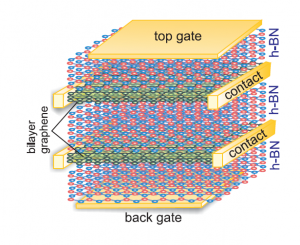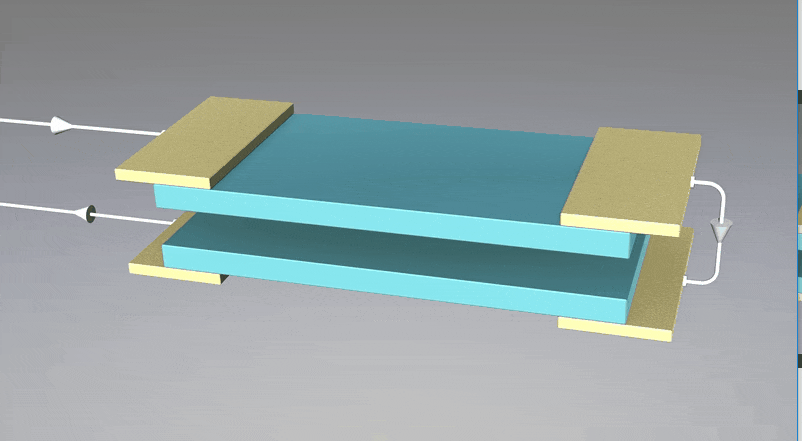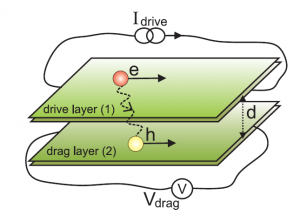Taking a multiband approach explains ‘electron-hole reverse drag’ and exciton formation
Mystifying experimental results obtained independently by two research groups in the USA seemed to show coupled holes and electrons moving in the opposite direction to theory.
Now, a new theoretical study has explained the previously mysterious result, by showing that this apparently contradictory phenomenon is associated with the bandgap in dual-layer graphene structures, a bandgap which is very much smaller than in conventional semiconductors.
The study authors, which included FLEET collaborator David Neilson at the University of Camerino and FLEET CI Alex Hamilton at the University of New South Wales, found that the new multiband theory fully explained the previously inexplicable experimental results.
Exciton transport
Exciton transport offers great promise to researchers, including the potential for ultra-low dissipation future electronics.
An exciton is a composite particle: an electron and a ‘hole’ (a positively charged ‘quasiparticle’ caused by the absence of an electron) bound together by their opposite electrical charges.
In an indirect exciton, free electrons in one 2D sheet can be electrostatically bound to holes that are free to travel in the neighbouring 2D sheet.
Because the electrons and holes are each confined to their own 2D sheets, they cannot recombine, but they can electrically bind together if the two 2D sheets are very close (a few nanometres).
If electrons in the top (‘drive’) sheet are accelerated by an applied voltage, then each partnering hole in the lower (‘drag’) sheet can be ‘dragged’ by its electron.
This ‘drag’ on the hole can be measured as an induced voltage across the drag sheet, and is referred to as Coulomb drag.
A goal in such a mechanism is for the exciton to remain bound, and to travel as a superfluid, a quantum state with zero viscosity, and thus without wasted dissipation of energy.

Device schematic: one sheet of conductive bilayer graphene carries electrons, the other, separated by insulating hBN, carries holes
To achieve this superfluid state, precisely engineered 2D materials must be kept only a few nanometres apart, such that the bound electron and hole are much closer to each other than they are to their neighbours in the same sheet.
In the device studied, a sheet of hexagonal-boron-nitride (hBN) separates two sheets of atomically-thin (2D) bilayer graphene, with the insulating hBN preventing recombination of electrons and holes.
Passing a current through one sheet and measuring the drag signal in the other sheet allows experimenters to measure the interactions between electrons in one sheet and holes in the other, and to ultimately detect a clear signature of superfluid formation.
Only recently, new, 2D heterostructures with sufficiently thin insulating barriers have been developed that allow us to observe features brought by strong electron-hole interactions.
Explaining the inexplicable: negative drag
However, experiments published in 2016 showed extremely puzzling results. Under certain experimental conditions, the Coulomb drag was found to be negative – i.e. moving an electron in one direction caused the hole in the other sheet to move in the opposite direction!
These results could not be explained by existing theories.
In this new study, these puzzling results are explained using crucial multi-band processes that had not previously been considered in theoretical models.
Previous experimental studies of Coulomb drag had been performed in conventional semiconductor systems, which have much larger bandgaps.
However bilayer graphene has a very small bandgap, and it can be changed by the perpendicular electric fields from the metal gates positioned above and below the sample.
The calculation of transport in both conduction and valence bands in each of the graphene bilayers was the ‘missing link’ that marries theory to experimental results. The strange negative drag happens when the thermal energy approaches the bandgap energy.
The strong multiband effects also affect the formation of exciton superfluids in bilayer graphene, so this work opens up new possibilities for exploration in exciton superfluids.
The study Multiband Mechanism for the Sign Reversal of Coulomb Drag Observed in Double Bilayer Graphene Heterostructures by M. Zarenia, A.R. Hamilton, F.M. Peeters and D. Neilson was published in Physical Review Letters in July 2018.
Acknowledgement the study was led by David Neilson, and by Mohammad Zarenia while at the University of Antwerp, Belgium. The authors of the theoretical study worked with data provided by experimentalists from the two US groups: Cory Dean (Columbia University) and Emanuel Tutuc (University of Texas at Austin) who discovered the original puzzling results. The research was supported by the Flemish government (Belgium), the University of New South Wales, the University of Camerino and by the Australian Research Council via FLEET.
Superfluids and FLEET
 Exciton superfluids are studied within FLEET’s Research theme 2 for their potential to carry zero-dissipation electronic current, and thus allow the design of ultra-low energy exciton transistors.
Exciton superfluids are studied within FLEET’s Research theme 2 for their potential to carry zero-dissipation electronic current, and thus allow the design of ultra-low energy exciton transistors.
The use of twin atomically-thin (2D) sheets to carry the excitons will allow for room-temperature superfluid flow, which is key if the new technology is to become a viable ‘beyond CMOS’ technology. A bilayer-exciton transistor would be a dissipationless switch for information processing.
In a superfluid, scattering is prohibited by quantum statistics, which means that electrons and holes can flow without resistance.
In this single, pure quantum state, all particles flow with the same momentum, so that no energy can be lost through dissipation.
FLEET (the Australian Research Council Centre of Excellence in Future Low-Energy Electronics Technologies) brings together over a hundred Australian and international experts, with the shared mission to develop a new generation of ultra-low energy electronics.
The impetus behind such work is the increasing challenge of energy used in computation, which uses 5–8% of global electricity and is doubling every decade.
A key challenge of such ultra-miniature devices is overheating – their ultra-small surfaces seriously limit the ways for the heat from electrical currents to escape.
More information
- Contact Prof Mohammad Zarenia, University of Missouri, Columbia zareniam@missouri.edu
- Contact Prof Alex Hamilton, UNSW alex.hamilton@unsw.edu.au
- Contact Prof David Neilson, University of Camerino dneilson@ftml.net
- Read Chasing the Electron condensate
- Contact FLEET media@FLEET.org.,au
- Visit FLEET.org.au
- Watch Future solutions to computation energy use
- Connect @FLEETCentre



